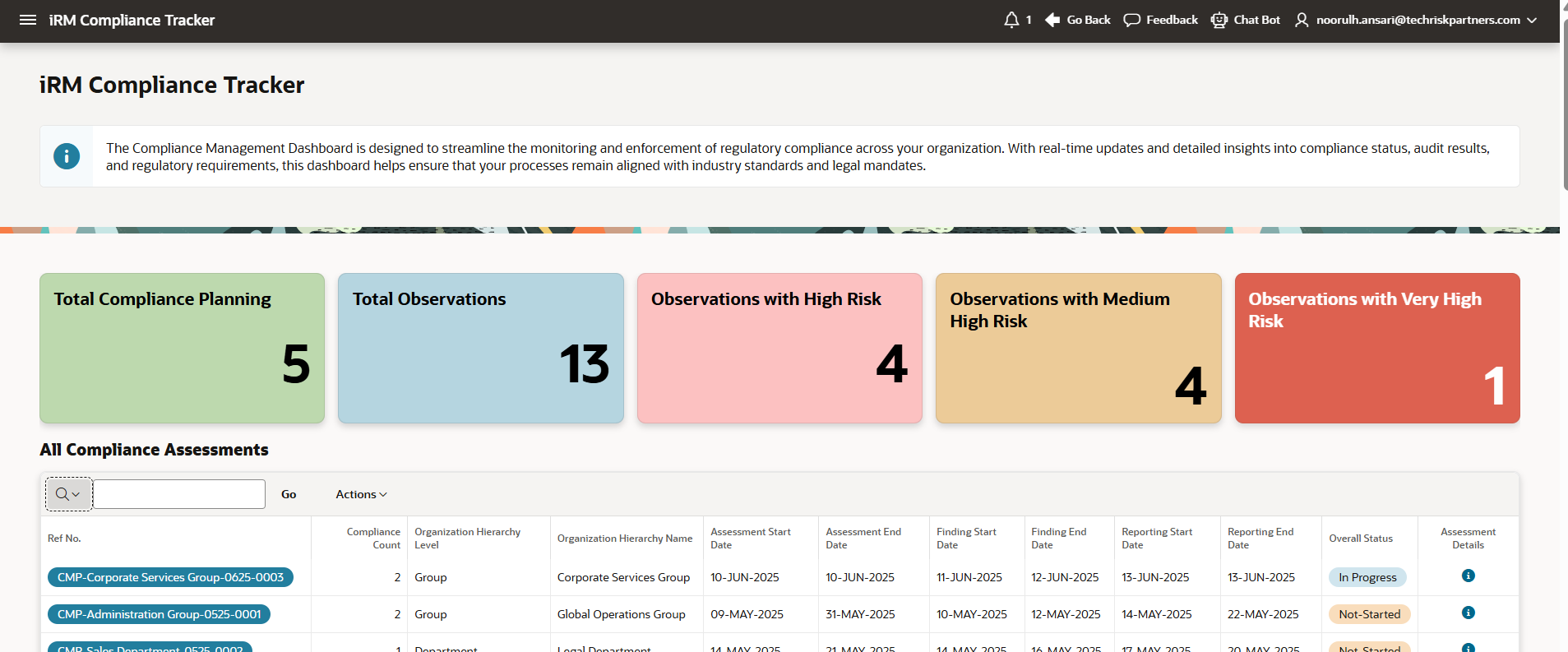


Streamlined Monitoring
Centralizes oversight of regulatory compliance across the organization.



Centralizes oversight of regulatory compliance across the organization.
Provides live updates on compliance status, audit results, and requirements.

.png)


.png)
Ensures business processes stay aligned with industry standards and legal mandates.

.png)

Minimizes non-compliance risks through proactive tracking and enforcement.
Make smarter decisions with a clear view of the facts. Our Enterprise and Operational Risk Management software gives you a full 360° perspective on risks across your business. With real-time, interactive dashboards, you can easily identify, assess, monitor, and respond to operational risks, all in one place.
✔ Evaluate risks across multiple dimensions with customizable impact and likelihood scales.
✔ Leverage robust built-in expertise to align with industry standards: COSO, ISO 31000, ORX, Advanced Measurement Approach (AMA) for Basel II/III.
✔ Perform qualitative or quantitative risk assessments.
✔ Use integrated Monte Carlo simulations to calculate value-at-risk and shortfall.
✔ Continuously monitor risks in your risk register by utilizing key indicators.
✔ Determine the financial impact of loss events through transaction analysis (e.g., lost revenue, insurance claims).
✔ Automate responses to events triggered by assessments, key risk indicators, incidents, control evaluations, and treatment plans
✔ Apply risk consolidation methods to efficiently summarize the risk profile of your business or organization.
✔ Maintain consistency and efficiency in data collection, action plan follow-up, and sign-off management.
✔ Foster business engagement with a collaborative interface and streamlined workflows.
✔ Provide easy access to information across all lines of defense.
✔ Monitor risk committee meeting details and communications effectively.
✔ Set ESG goals (such as greenhouse gas emissions, sustainable investments, executive compensation) and track progress with measurable metrics.
✔ Integrate with third-party tools and services to monitor key risk indicators.
✔ Pre-configured executive-level reports that are easily customizable to fit your needs.
✔ Leverage advanced analytics to elevate your insights to the next level.
✔ Risk and Control Self-Assessment - Facilitates both top-down and bottom-up assessments with methods to consolidate and summarize the risk profile of a business unit or the entire organization. Offers extensive configuration options, including risk dimensions, impact and likelihood scales, and more.
✔ Loss & Incident Management - Advanced workflows encompass capturing, notifying, routing, escalating, and conducting investigations and root cause analyses of losses and incidents.
✔ Dashboards & Analytics - Get real-time insights into your risk program with customizable reports and dashboards, featuring various visualization options like drill-down heat maps, risk trends, and top risks, along with detailed overviews and relevant information.
✔ Risk Mitigation - Optimize the management of action plans through automated and customizable workflows that assign responsible parties with triggers—like emails, escalations, management approvals, and reports—to ensure timely resolution.
✔ Indicators Monitoring - Capture and report on key risk indicators (KRIs), set thresholds that trigger actions, and easily identify trends with effective KRI management.
ERM is a strategic approach to identifying, assessing, and managing risks across an organization, enhancing decision-making and operational resilience. It helps in proactively addressing risks to ensure business continuity and achieve organizational goals.
iRMCloud's easy-to-use dashboards provide a centralized, intuitive view of all risk-related data, making it simpler for managers to monitor, analyse, and respond to risks in real-time, thereby improving the efficiency and effectiveness of the organization's risk management process.
iRMCloud enhances ERM by offering user-friendly dashboards for a clear overview of risks, latest risk insights out-of-the-box for immediate risk identification, an inbuilt risk matrix for simplified risk evaluation, and regular updates to stay aligned with evolving risk landscapes.
The inbuilt risk matrix in iRMCloud simplifies the complexity of risk assessment by categorizing risks based on their severity and likelihood, aiding in prioritizing risks and formulating strategic responses, thus making the decision-making process more streamlined and data-driven.